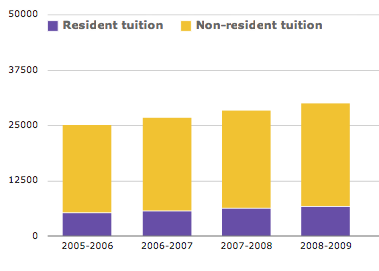Sunday, November 24, 2013
Research Blog #9: Argument and Counter-Argument
The argument that I am proposing in my paper is that universities are being unfair to non resident students with what they are charging them for tuition. They expect these students to even out the funding that they do not have for the university just because they are not a resident of the state. They feel that residents should not suffer from the high charges of tuition because they pay the taxes that are funding the university. It would be unfair to charge the students double with taxes and tuition. “‘State universities were built with public and tax dollars — and for Mexicans, Asian-Americans and all the others [in state] — not to give them a priority, I think it’s outrageous,’ said Mitchem, whose organization seeks to expand college opportunities for the disadvantaged” These schools were built mainly for these residents to attend and it is only right to give non-residents higher tuition rates for attending the university. However this argument is outrageous. The tax dollars that the residents pay generally only help twenty percent of universities' funding. There is no way that that amount of money in tax dollars can equal up to the non-resident fees that students pay yearly. “State appropriations and aid account for less than 20 percent of Carolina’s $2.4 billion operating budget.” There is no way that it could be fair that you are serving the students of the state because they have earned the privilege when really they have done nothing.
Research Blog #7: Your Case
The case that I really want to make in my research paper is that tuition for residents and non-residents should be equal. Universities are charging non-residents such high rates to continue funding a school which I find to be unfair. The use of tuition is no longer about helping the school, but has become a political scheme. Universities are very concerned about having the right amount of funding to their school thrive. The quickest and easiest way universities felt they could solve the problem with funding was having non-residents pay a great amount of tuition to even the funding that is needed. Below I will show quotes, videos, and graphs that prove the case the I am making.
“state appropriations and aid account for less than 20 percent of Carolina’s $2.4 billion operating budget.”
“enrollment growth across the UNC system was fully funded, the legislature allocated $60 million for building repair and renovations, and legislatively mandated tuition hikes for out-of-state students were confined to undergraduates.”
“Over the past 30 years, SUNY has charged nonresident students an average of 2.4 times more than resident students”
“with public universities getting less of their funding from the states, it’s hard to argue that their priority should be state residents, according to Dr. Carlos Santiago, chief executive officer of the Hispanic College Fund”
“When schools shift to favor out-of-state students, says Nassirian, it drives the price of education up and makes it difficult for Hispanics, and minorities in general, to gain access to higher education.”
http://www.wbrz.com/videos/southern-drops-out-of-state-tuition/

“state appropriations and aid account for less than 20 percent of Carolina’s $2.4 billion operating budget.”
“enrollment growth across the UNC system was fully funded, the legislature allocated $60 million for building repair and renovations, and legislatively mandated tuition hikes for out-of-state students were confined to undergraduates.”
“Over the past 30 years, SUNY has charged nonresident students an average of 2.4 times more than resident students”
“with public universities getting less of their funding from the states, it’s hard to argue that their priority should be state residents, according to Dr. Carlos Santiago, chief executive officer of the Hispanic College Fund”
“When schools shift to favor out-of-state students, says Nassirian, it drives the price of education up and makes it difficult for Hispanics, and minorities in general, to gain access to higher education.”
http://www.wbrz.com/videos/southern-drops-out-of-state-tuition/
Literature Review #5
Citation:
Baoyan, Cheng. "College Choices: The Economics Of Where To Go, When To Go, And How To Pay For It." 76.1 (n.d.): 110-120. Web. 24 Nov. 2013.
Summary:
The chapter that was most appealing to my work was chapter 7. This chapter is about the reason why universities charge so much for non-resident tuition. It also gave ways that universities could find funding that would help them continue to thrive as they should without having to be unfair to students. This book also gives ideas for students to have financial needs and grants to help them thrive in their college career without dealing with a lot of debt.
Author:
Caroline M. Hoxby
Key Terms:
flagships, enrollment, grant aid, and revenue
Quotes:
"Legislators and their constituents may also prefer not to fund institutions directly because they may worry that the dollars will not go to the intended uses"
"Time will tell if [public higher education] will increasingly turn to out-of-state students' tuition revenues to fill the holes in their budgets."
Value:
This book gives great data to help understand the idea of tuition payments, enrollment, and the growth of tuition as well.
Sunday, November 3, 2013
Research Blog 6: Visual

This graph is a demonstration of how tuition has become very unfair for non-resident students. This graph is a representation of the University of Washington's change in tuition. There is a clear tuition increase for non-resident student in just over 4 years, while tuition stays constant for residents. This graph shows how the increases of tuition have been really unfair. Non-resident students should not have to suffer in payments just to help fund a school.
Subscribe to:
Posts (Atom)